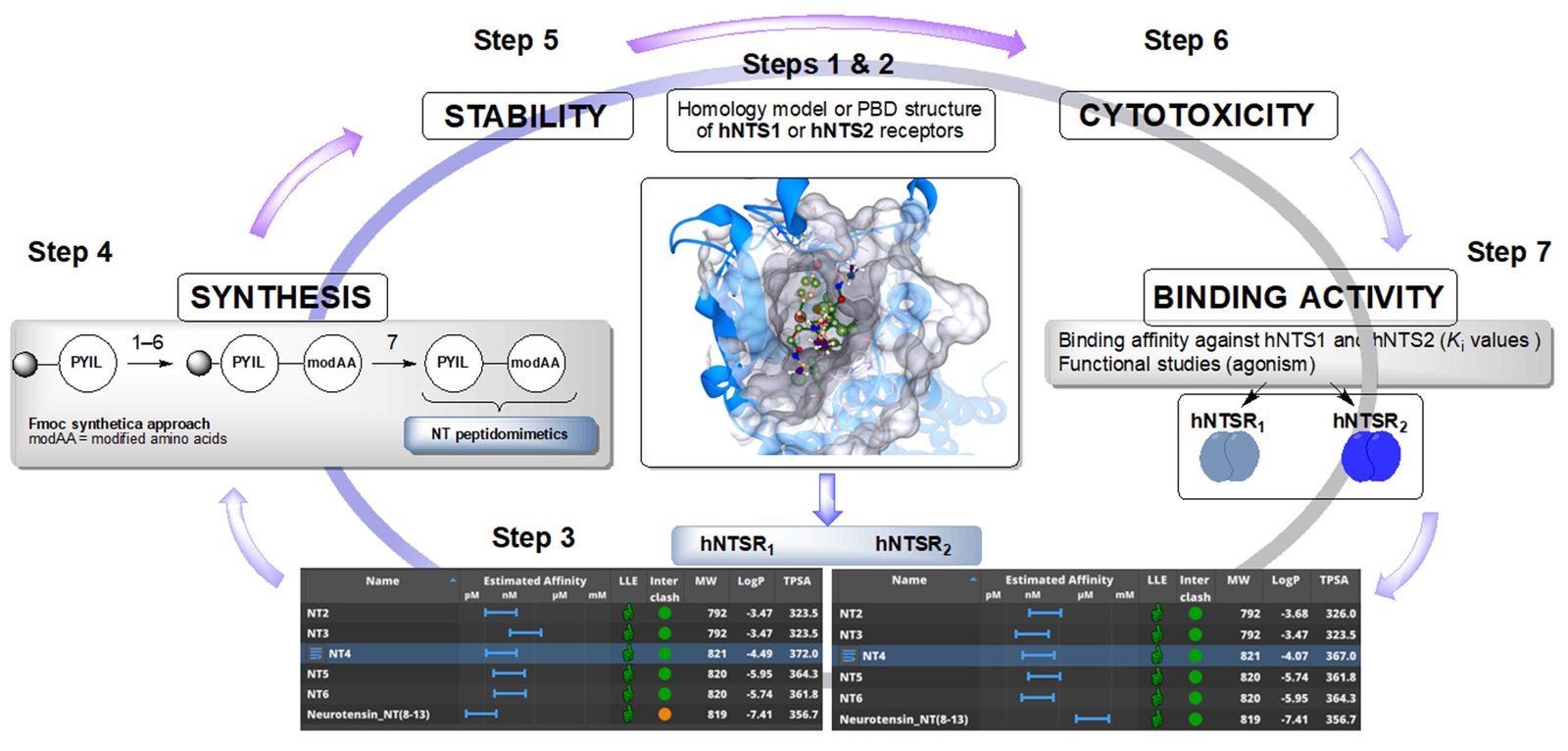Multinational project with participants from Bulgaria, Germany, and Austria/Poland, supported by the Bulgarian National Scientific Fund (BNSF)
project contract No. КП-06-H 59/2
duration 36 months (2022-2024)
Project coordinator: Assoc. Prof. Dr. Nikolay T. Tzvetkov
The tridecapeptide neurotensin (NT) is widely distributed in the central nervous system (CNS) and periphery, acting as a neurotransmitter or neuromodulator in the brain and a local hormone in the gastrointestinal tract, respectively. Based on its distribution, NT exhibits diverse biological effects, such as non-opioid analgesia, hypothermic and antipsychotic properties. It is known that the C-terminal part of NT, namely the hexapeptide NT(8-13) with the amino acid (AA) sequence H-Arg8-Arg9-Pro10-Tyr11-Ile12-Leu13-OH, represents the biologically active fragment of NT.
Therefore, this AA sequence is considered as a lead structure for the development of NT analogues as potential therapeutic or imaging agents, e.g., for the treatment of pain, neurological diseases, Parkinson´s disease or radiodiagnosis of several malignant tumors.
The main goal of this project will be the establishment of a state of the art technology platform to construct novel dual-acting NTSR1-NTSR2 ligands as potential therapeutic or imaging agents for further research or diagnostic use, combining dual affinity towards NTS1 and NTS2 receptors with agonistic mode of action.
In order to obtain the structures of neurotensin peptidomimetics, the following steps are planed to be performed:
- Step 1 – Selection of suitable co-crystal structures of human NTS1 and NTS2 receptors using free available PDB database (https://www.rcsb.org/). If not available, the homology models of the hNTS1 and hNTS2 will be generated using the respective free available rat receptor structures;
- Step 2 –Selection and generation of peptidomimetics (NT(8-13)+modAA) in SeeSAR;
- Step 3 – Scoring and physicochemical evaluation of the selected virtual peptidomimetics using HYDE scoring function in SeeSAR. It will serves to analyse the binding mode of a small set of virtually generated peptidomimetics and allowed an in silico estimation of their structure-activity relationships (SARs). This will enable us to select structural elements (core structures) whose variation looks promising in order improved potency towrads the targeted NTS1 and NTS2 receptors;
- Step 4 – Synthesis of the top-scored in Step 3 neurotensine peptidomimetics using 7-steps Fmoc synthetic strategy. The synthetic strategy, for example, involves a consequently conjugation of a modified amino acids (modAA) with the core structure of the NT(8-13) (formed from 3 or 4 amino acids) and deprotection reaction of the final structure. In this step 4 are involved, isolation, purification and structural characterization of the new peptidomimetics;
- Steps 5 and 6 – Stability (chemical and protease) and cytotoxicity studies of the new synthesized peptidomimetics will be performed in order to found the most suitable one for further in vitro biological evaluation;
- Step 7 – In vitro evaluation of binding affinities and functional analysis of agonism of the new neurotensine peptidomimetics.
The aims of the current project could be feasible due to an integral and interdisciplinary technology approach that we are tackling ranging from in silico design and virtual screening of the peptidomimetics, followed by their synthesis, investigation of their stability, cytotoxicity, and in vitro evaluation in radioligand binding affinity and functional studies.
For more information, please contact us at: ntzvetkov@bio21.bas.bg
Keywords: Neurotensins, Neurotensin receptors, Parkinson´s disease, Neurodegenerative diseases, Virtual screening.


